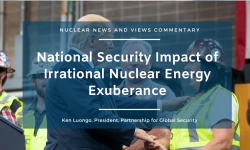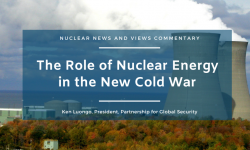A longer version of this article will be published soon by The Center for the National Interest and it can be found here.
In the sea of enthusiasm for the global expansion of commercial nuclear power, there are modern day Nostradamus’ confidently predicting failure.
“Most SMRs are on paper […] These are fun ideas. But the tech bros don’t seem to be grounded in reality” prophesized a Former Nuclear Regulatory Commission chairperson in a recent BBC interview.
On social media, a noted nuclear power critic predicted, “you must know that none of this is actually going to happen” when referring to new nuclear microreactors “that are doomed to fail.”
It is very possible that these criticisms will be proven correct. As the critics note, there are lots of MOU’s and paper reactors, but not much groundbreaking.
But a review of key issues indicates that while small reactors face some real headwinds, and some reactor designs may face more challenges than others, the volume and depth of the political, financial, and technological commitment to their success could push them forward to commercialization.
AI Energy Expansion
The Trump administration is dead set on winning the AI race with China and nuclear energy is a serious contender for powering U.S. AI data centers.
Today the U.S. has 522 data centers, about half of the world’s total. Another 280 are expected to come online by 2028. This would jump energy demand in this sector from 2% of total U.S. electricity to 12%.
The U.S. is currently adding only about 65 gigawatts to the grid but an ICF International analysis states it, “should be adding about 80 gigawatts of new power generation capacity a year to keep pace with AI as well as cloud computing, crypto, industrial demand, and electrification trends.”
Other SMR Applications
The critics believe that the challenges of achieving commercialization will sink small reactors through the trifecta of concerns about reactor cost effectiveness, licensing ability, and delivery certainty.
But AI is not the only application for small reactors. There are industrial applications and disaggregated grid uses that exist in developed and developing countries.
Canada already has approved the construction of four 300 MW General Electric Hitachi BWRX reactors at the Darlington nuclear plant. If licensed, these would become the first commercial SMRs operating in North America.
Financing
The Trump administration has revamped the Department of Energy’s Loan Program Office into the Energy Dominance Financing Program (EDF), and it seems prepared to provide tens of billions of dollars in nuclear project loans. U.S. government financing will likely mitigate some of the risks private investors will face.
The administration’s decision to identify federal land for nuclear plant construction is also a significant step. Some small reactor companies have already set up on national laboratory territory.
Fuel Supply
Access HALEU and plutonium nuclear fuel is a major bottleneck for small reactors. Both the Biden and Trump administrations made revitalizing U.S. nuclear fuel production a priority and have devoted billions to uranium enrichment and millions to plutonium reprocessing and fuel use.
Nuclear critics have cited security problems associated with the use of HALEU and weapon-grade plutonium. For now, there is a push forward on multiple nuclear fuel fronts, but it is not certain that they will succeed in substantially opening the reactor fuel bottleneck.
SMR Export Markets
Small reactors have significant applicability as an export technology, particularly to developing economy nations with growing populations and energy demand. But negotiating and approving agreements for nuclear cooperation with these nations is a slow process.
What is missing is the ability to target countries and apply the full scope of technical and financial resources needed to capture the market for the U.S. Clearpath, has developed the concept of Energy Security Compacts (ESC) that propose five-to-ten-year agreements with nations to build their capacity. This concept would strengthen the U.S. against the state-financed companies of Russia and China and open overseas markets.
Military Reactors
U.S. Department of Defense has made a major commitment to the development of small reactors through Project Pele and the Janus Program. And turning emerging technologies into usable products is a key DoD talent.
The PELE reactor is a 1.5-megawatt TRISO-fueled, gas-cooled demonstration micro reactor that is designed to provide the U.S. military with “a mobile, reliable, sustainable, and resilient power source which does not require a long logistics tail.”
The Janus project was launched in October 2025 and is designed to be a 1-20 megawatt reactor that provides power for national defense facilities and critical missions. The Janus reactors will be commercially owned and operated and could provide power to the local grid.
Ken Luongo, President, Partnership for Global Security





